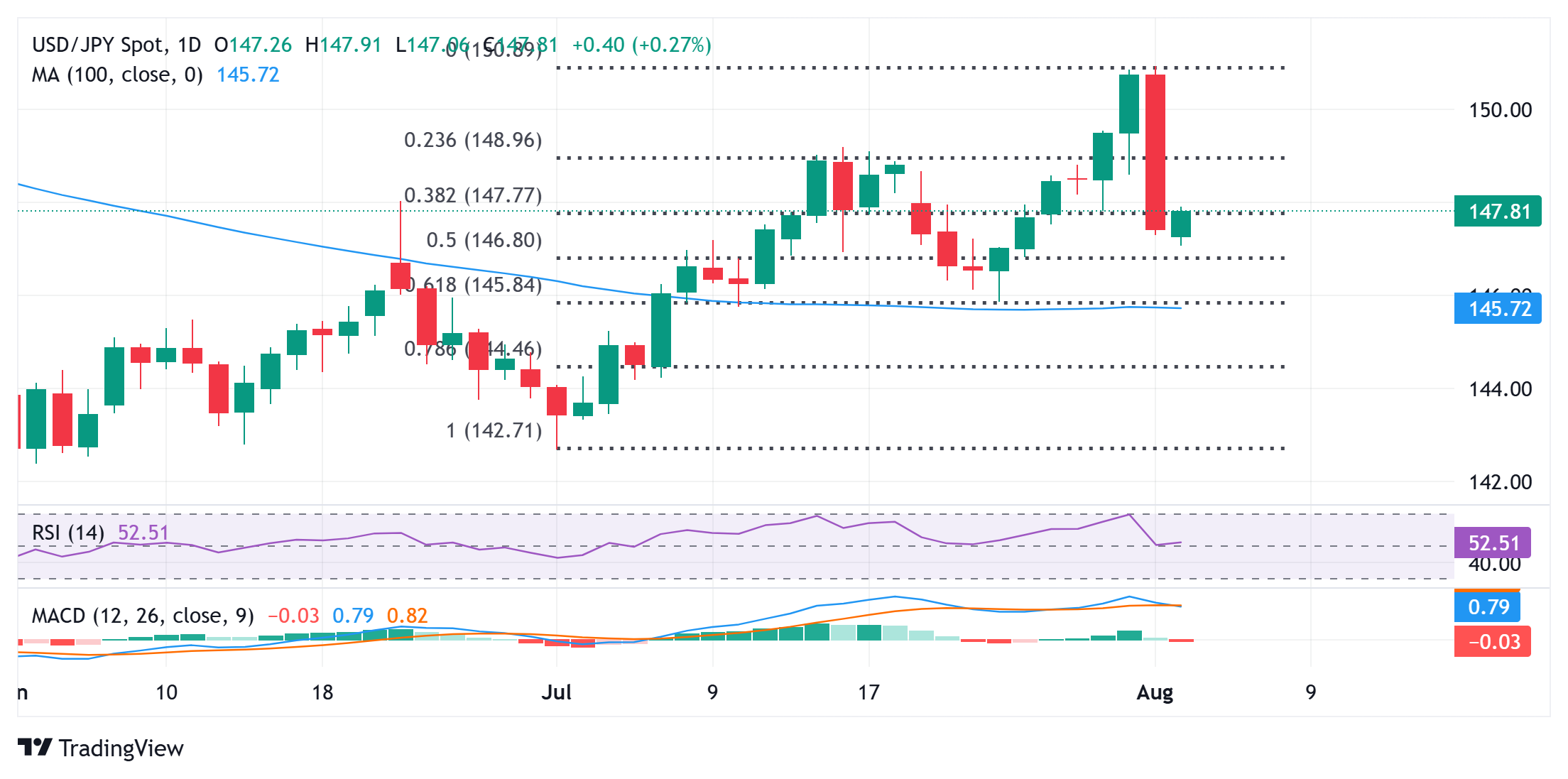Japanese Yen drifts lower as USD stalls Friday’s softer US NFP-inspired steep decline

- The Japanese Yen kicks off the new week on a softer note amid reduced BoJ rate hike bets.
- The USD reverses a part of Friday’s post-NFP slump and further lends support to USD/JPY.
- Firming expectations for a September Fed rate cut might cap the USD and the pair.
The Japanese Yen (JPY) attracts some sellers at the start of a new week and stalls its sharp recovery move from a four-month low touched against its American counterpart on Friday. The Bank of Japan (BoJ) last week acknowledged the uncertainty over the economic impact of higher, 15% US tariffs on Japanese exports and signaled continued policy patience. Adding to this, domestic political uncertainty could further complicate the BoJ's policy normalization path, which turns out to be a key factor undermining the JPY during the Asian session.
Meanwhile, Friday's dismal US jobs report revived US economic concerns and tempered investors' appetite for riskier assets, which is evident from a weaker tone around the equity markets and could offer support to the safe-haven JPY. The US Dollar (USD), on the other hand, might struggle to gain any meaningful traction amid bets for an imminent resumption of the Federal Reserve's (Fed) rate-cutting cycle in September. This might contribute to capping any further appreciating move for the USD/JPY pair and warrants caution for bulls.
Japanese Yen attracts fresh sellers amid diminishing odds for an immediate rate hike by the BoJ
- The US Bureau of Labor Statistics (BLS) reported on Friday that the economy added 73K new jobs in July, compared to the market expectation of 110K. Adding to this, the change in total Nonfarm Payroll employment for May was revised down 144K to 19K, and the change for June was revised down from 147K to 14K.
- Other details of the report showed that the Unemployment Rate edged higher to 4.2% from 4.1% in June, as expected, while the Average Hourly Earnings rose to 3.9% from 3.8%. Traders were quick to react and are now pricing in over an 80% probability of a rate cut by the Federal Reserve at the September policy meeting.
- Moreover, the CME Group's FedWatch Tool now implies around 65 basis points of Fed easing by the end of this year. Adding to this, the Fed said that Governor Adriana Kugler is resigning early from her term on August 8, which triggered a steep decline in the US Treasury bond yields and weighed on the US Dollar on Friday.
- The USD/JPY pair tumbled over 350 pips from the vicinity of the 151.00 mark, or the highest level since late March, though it found some support near the 147.00 round figure during the Asian session on Monday. Diminishing odds for an immediate rate hike by the Bank of Japan cap the upside for the Japanese Yen.
- The BoJ revised its inflation forecast at the end of the July meeting last week and reiterated that it will continue to raise the policy rate if the economy and prices move in line with the forecast. BoJ Governor Kazuo Ueda, however, downplayed inflation risks and didn't show any real intention to hike rates anytime soon.
- Ueda further added that the BoJ will look at the data to come out without any preconception and make an appropriate decision at each meeting. Moreover, the ruling Liberal Democratic Party’s loss in July suggests that prospects for BoJ rate hikes could be delayed for a bit longer, which is seen weighing on the JPY.
- Traders now look forward to the release of US Factory Orders for some impetus later during the North American session and ahead of the BoJ Monetary Policy Meeting Minutes on Tuesday. Apart from this, the broader risk sentiment and the USD price dynamics should contribute to producing short-term trading opportunities around the USD/JPY pair.
USD/JPY finds some support near 147.00; upside potential seems limited

Friday's breakdown and close below the 38.2% Fibonacci retracement level of the rally from the July swing low was seen as a key trigger for the USD/JPY bears. However, oscillators on the daily chart – though they have retreated from higher levels – are still holding in positive territory. This, in turn, assists the currency pair to find some support ahead of the 50% retracement level, which is pegged near the 146.80-146.75 region and should act as a pivotal point. A sustained break below the said support should pave the way for a fall towards the 146.00 mark en route to the 145.85 zone, or the 61.8% Fibo. retracement level.
On the flip side, any subsequent recovery is more likely to confront an immediate hurdle near the 148.00 mark, above which the USD/JPY pair could climb to the 148.60 horizontal barrier. The subsequent move up could lift spot prices to the 149.00 mark, or the 23.6% Fibo. retracement level. A sustained strength beyond the latter will shift the bias back in favor of bullish traders and allow the currency pair to reclaim the 150.00 psychological mark with some intermediate resistance near the 149.50 region, or the very important 200-day Simple Moving Average (SMA).
Japanese Yen FAQs
What key factors drive the Japanese Yen?
The Japanese Yen (JPY) is one of the world’s most traded currencies. Its value is broadly determined by the performance of the Japanese economy, but more specifically by the Bank of Japan’s policy, the differential between Japanese and US bond yields, or risk sentiment among traders, among other factors.
How do the decisions of the Bank of Japan impact the Japanese Yen?
One of the Bank of Japan’s mandates is currency control, so its moves are key for the Yen. The BoJ has directly intervened in currency markets sometimes, generally to lower the value of the Yen, although it refrains from doing it often due to political concerns of its main trading partners. The BoJ ultra-loose monetary policy between 2013 and 2024 caused the Yen to depreciate against its main currency peers due to an increasing policy divergence between the Bank of Japan and other main central banks. More recently, the gradually unwinding of this ultra-loose policy has given some support to the Yen.
How does the differential between Japanese and US bond yields impact the Japanese Yen?
Over the last decade, the BoJ’s stance of sticking to ultra-loose monetary policy has led to a widening policy divergence with other central banks, particularly with the US Federal Reserve. This supported a widening of the differential between the 10-year US and Japanese bonds, which favored the US Dollar against the Japanese Yen. The BoJ decision in 2024 to gradually abandon the ultra-loose policy, coupled with interest-rate cuts in other major central banks, is narrowing this differential.
How does broader risk sentiment impact the Japanese Yen?
The Japanese Yen is often seen as a safe-haven investment. This means that in times of market stress, investors are more likely to put their money in the Japanese currency due to its supposed reliability and stability. Turbulent times are likely to strengthen the Yen’s value against other currencies seen as more risky to invest in.







